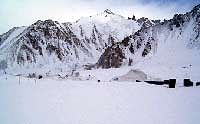
Considered most strategic in terms of defence needs of the country and manned round-the-clock at temperatures of minus 50 to 60 degrees during winters, the meltdown is a "warning bell to the health and security of Siachen," writes Bansi Lal Kaul of the UNDP India's Solutions Exchange wing in his book, "Biodiversity Conservation in Himalayas".
"It is unfortunate that Siachen Glacier nowadays has receded more than 800 m during 20-year period from 1988 to 2008," the 326-page book says.
With over 3,000 troops living and operating there, hundreds of machines and scores of choppers flying daily over the region, the whole of its environment and eco-system have deteriorated, former chief scientist at the Sher-e-Kashmir University of Agriculture R D Gupta writes in one of the chapters titled "Global Warming and Melting of Himalayan Glaciers".
The book blames military activities for depositing tonnes of chemicals on the surface of the glacier, thereby not only polluting the headwaters of Indus river but also raising the temperatures in the area.
Referring to an in-house study by the army, the book states that 75 per cent of waste generated are bio-degradable, including human waste.
"Claims made by the army to preserve the snow-white colour of the glacier while holding this highest battlefield of the world seem to be mere words of promise," the book says.
With pieces written by experts in the field on different subjects connected with Himalayas, the volume covers wide range of topics having direct bearing on the health and security of the most outstanding yet fragile Himalayan eco-system.